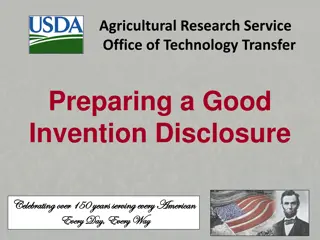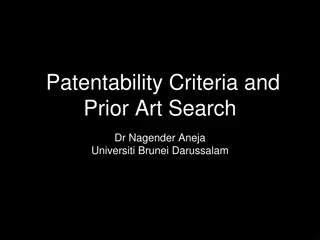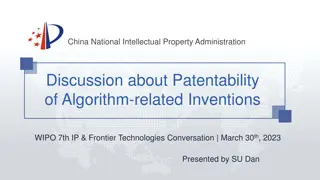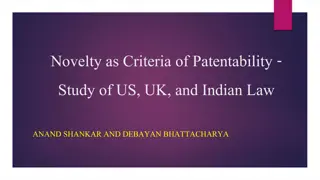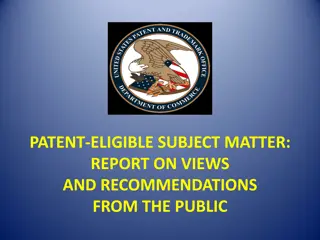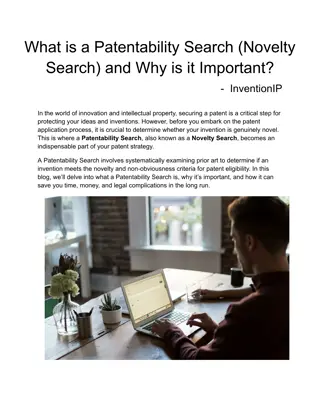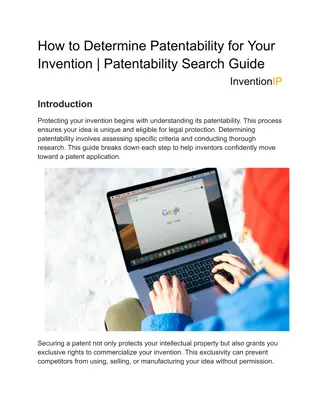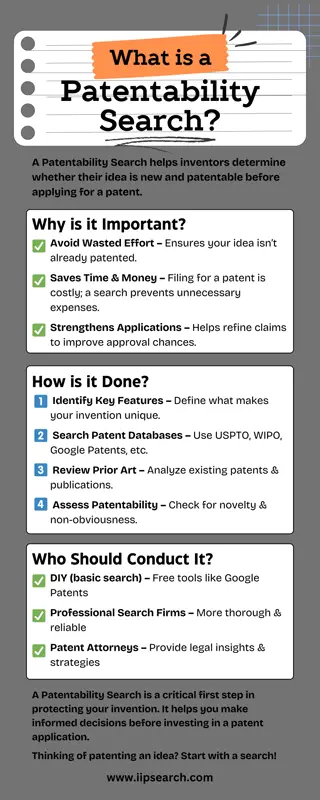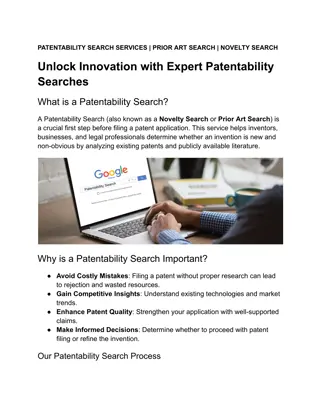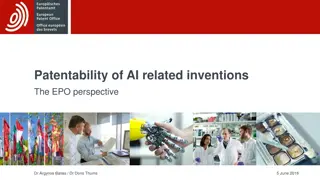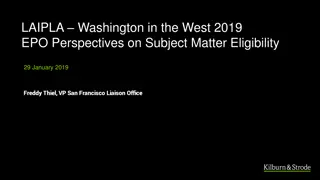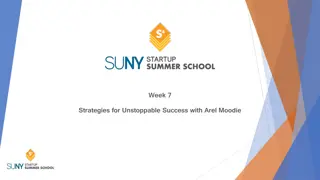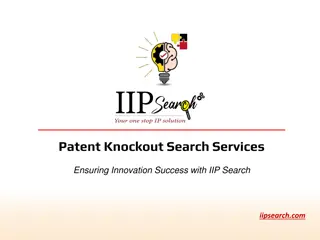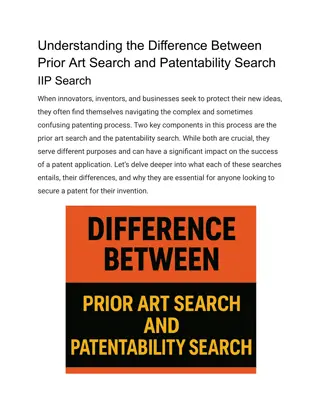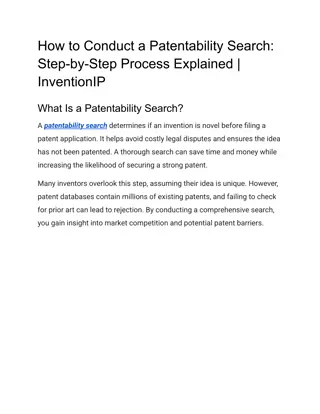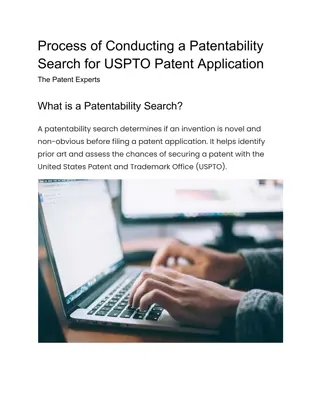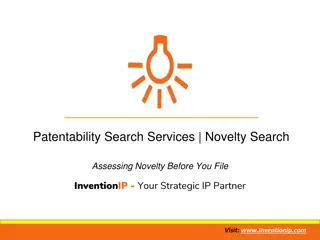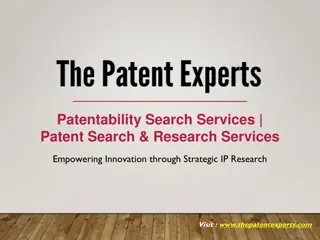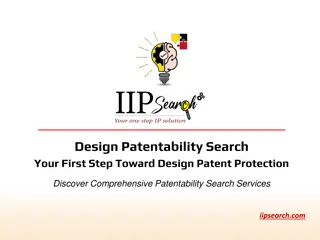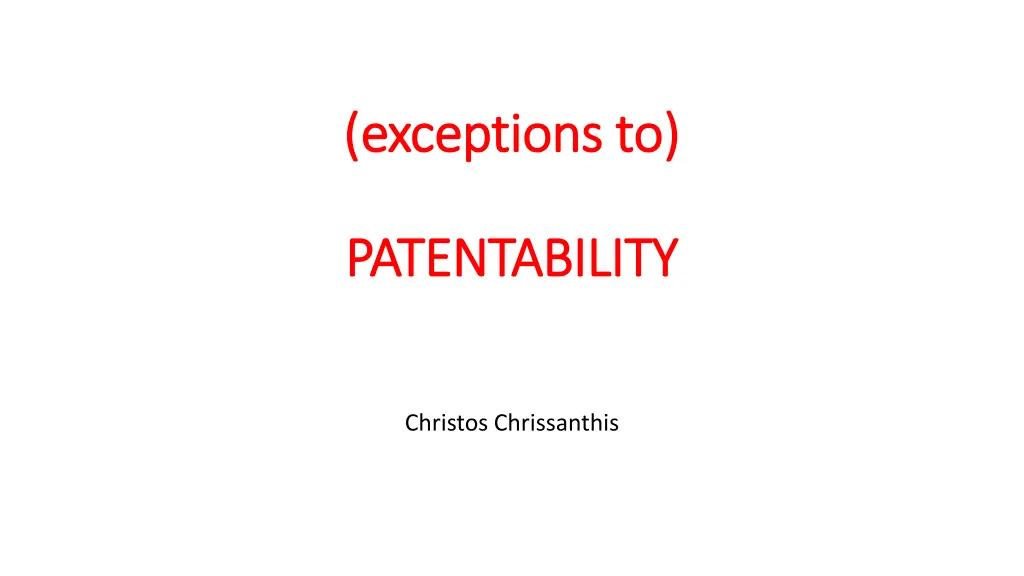
Exceptions to Patentability Explained: Discoveries & Synthetic Genes
Explore major exceptions to patentability including discoveries and scientific theories. Understand why discoveries are not protected by patents due to their broad nature and potential societal implications. Dive into case studies like Parke Davis (1911) and Association for Molecular Pathology v. Myriad (2013) for insights on patenting discoveries such as isolated insulin and synthetic genes.
Download Presentation

Please find below an Image/Link to download the presentation.
The content on the website is provided AS IS for your information and personal use only. It may not be sold, licensed, or shared on other websites without obtaining consent from the author. If you encounter any issues during the download, it is possible that the publisher has removed the file from their server.
You are allowed to download the files provided on this website for personal or commercial use, subject to the condition that they are used lawfully. All files are the property of their respective owners.
The content on the website is provided AS IS for your information and personal use only. It may not be sold, licensed, or shared on other websites without obtaining consent from the author.
E N D
Presentation Transcript
(exceptions to) (exceptions to) PATENTABILITY PATENTABILITY Christos Chrissanthis
Major exceptions to patentability Major exceptions to patentability DISCOVERIES ABSTRACT IDEAS SCIENTIFIC (MATHEMATICAL) THEORIES
DISCOVERIES DISCOVERIES Justification for the exception: Granting patents on discoveries would result to substantial adverse consequences for the pubic. It would be extremely difficult to describe in precise terms the object of a discovery and the many and different applications it might have. Consider why discoveries are not protected by patent law. Discoveries need funding, investment, effort and are beneficial to society. For example, what would happen if the so called "basic research" was protected under patents? The problem with discoveries is that they can have many different applications that are not even known from the beginning; so, the subject matter of the right would be very broad.
PARKE DAVIS, 1911 A patent for "isolated and enriched" insulin. Insulin is a substance that exists in nature, but not isolated and enriched, but always mixed with other substances. In the laboratory they managed to isolate and enrich (refine) it. It was held that "isolated and enriched" insulin is patentable despite being a naturally occurring substance, because in nature it is not isolated and enriched. Issues: Can you register clones or chimeras (eg half animal, half human)? These do not exist in nature. Man creates them. But they are living organisms. - Can you patent synthetic genes? Genes are of great interest for the genetic information they carry. This information is the same in both natural and synthetically created genes. That is, the genetic information that is the quintessence of genes exists in nature.
ASSOCIATION FOR MOLECULAR PATHOLOGY v MYRIAD, 2013 The object of the invention concerned a method for isolating a specific gene in DNA . This gene was responsible for causing some forms of cancer. By isolating this gene we can in the first phase prepare synthetic DNA and in the second phase prepare diagnostic tests for the diagnosis of specific forms of cancer. With this patent application, exclusivity was claimed both for the isolation method, for the synthetic DNA as a product, and for the diagnostic tests you could prepare as products. It was felt that this method of isolating the particular gene was not actually something new. In fact, what this invention had achieved was not the isolation of the gene by a new method, but the innovation was that they had identified exactly where in the DNA sequence the gene was located. Once the position of the gene was identified, it was easy to isolate it based on the technology we already knew. So, it's about a discovery (where exactly the gene is). But the claim for synthetic DNA as a product was legitimate, because it was man-made and did not exist in nature. Again the concern is that the gene and DNA are actually nothing more than genetic information that exists in nature by itself.
DIAMOND v. CHAKRABARTY, 1980 Synthetic bacterium (living organism) that ate oil. It did not exist in nature but was created in the laboratory. Method claims for the production of the bacterium and for the manner of its use were initially accepted The product claim on the bacterium itself was challenged. Initially the claim was rejected, mainly because it was a living organism, but the Appeal Court accepted it. According to the judgment, anything that is created by man and does not exist by itself in nature can be the subject matter of a patent.
MAYO v . PROMETHEUS, 2012 A patent application was filed where the invention was the measurement of certain indicators in the blood and based on these indicators the assessment of whether the dosage of a drug should be increased or decreased, to enhance the effectiveness of the treatment or to prevent side effects respectively. It was thought to be a simple idea for a simple application of laws of nature. It was more of a discovery than an invention. The Appeal Court noted that the fact that a discovery may require investment, effort, time, etc. is not sufficient to justify the granting of an exclusive right, because the risk of limiting competition, limiting future technological development and the risk of limiting the diffusion of of knowledge from patenting discoveries is disproportionately large. The Appeal Court distinguished the case of the second medicinal use.
ABSTRACT IDEAS Abstract ideas can have many different applications. So, the subject matter of the patent claimed is very broad. Abstract ideas somehow pre-exist in nature and you conceive them, not create them.
GOTTSCHALK, 1972 A patent for converting coded information into a binary number system format so that it can be processed by a computer. It is not registerable, because it is a very simple and very general and abstract idea.
DIAMOND v DIEHR, 1981 A method patent for molding raw synthetic rubber into high precision solid products based on the use of software and a mathematical equation. The claims also included the mathematical equation that took into account parameters such as temperature, material pressure, etc. The question was whether it is admissible to register a mathematical equation. The mathematical equation is in principle an abstract idea. It was held that the mathematical formula was patentable because it was part of a larger process and not a single and self-contained mathematical equation. The method was much more than just a mathematical equation.
BILSKI v. KAPPOS , 2010 A patent for a method for hedging business risks from fluctuating energy prices formulated and in the form of a mathematical equation. It was deemed inadmissible for registration, because it was not even a method, but only a simple and completely abstract idea. Earlier jurisprudence held that for a patent to be admissible for registration, a machine or a change in the form of a substance had to be shown ( machine or transformation ). In the Bilski case the annulment said that the criterion machine or transformation is not the sole or exclusive criterion for what is patentable.
ALICE v CLS BANK, 2014 Invention for a method of managing business (credit) risk in clearing transactions in clearing systems. It was held to be inadmissible for filing because it was no more than a simple and general idea.

